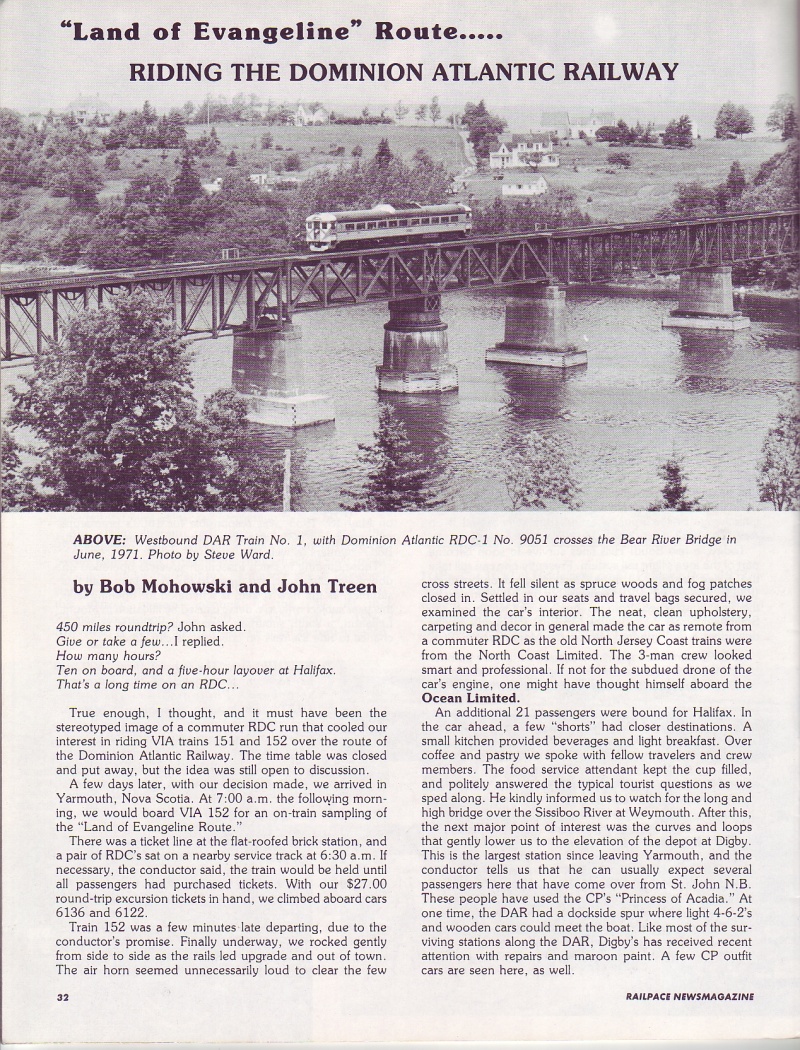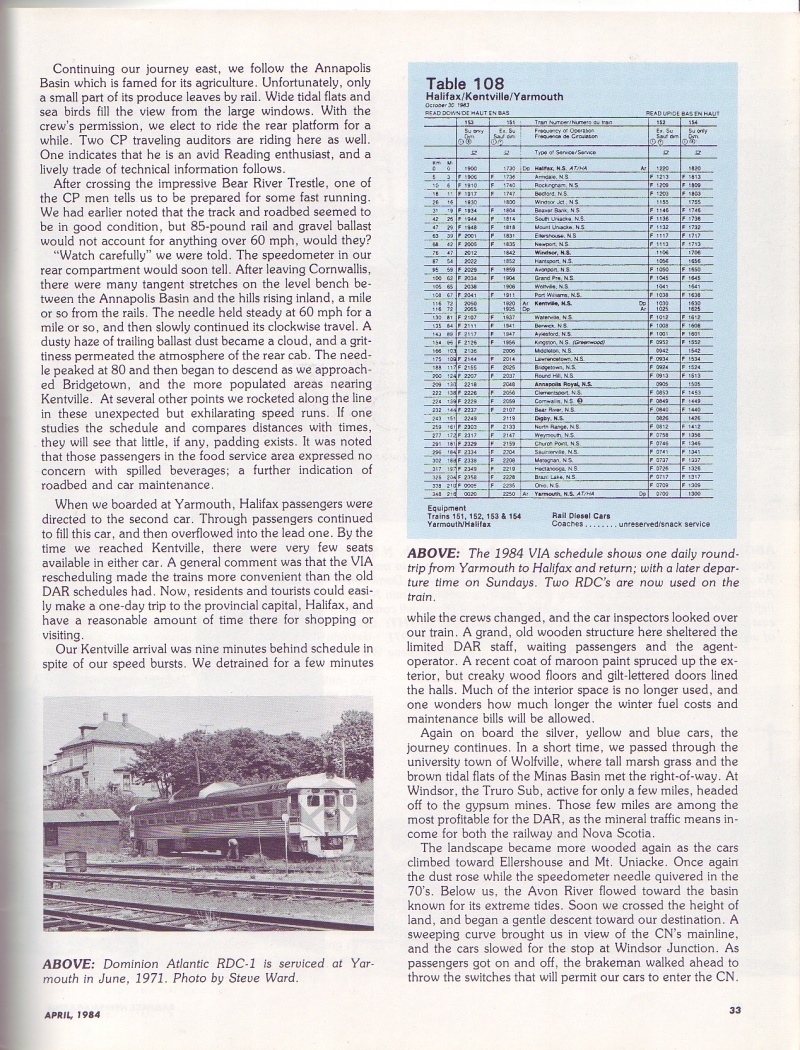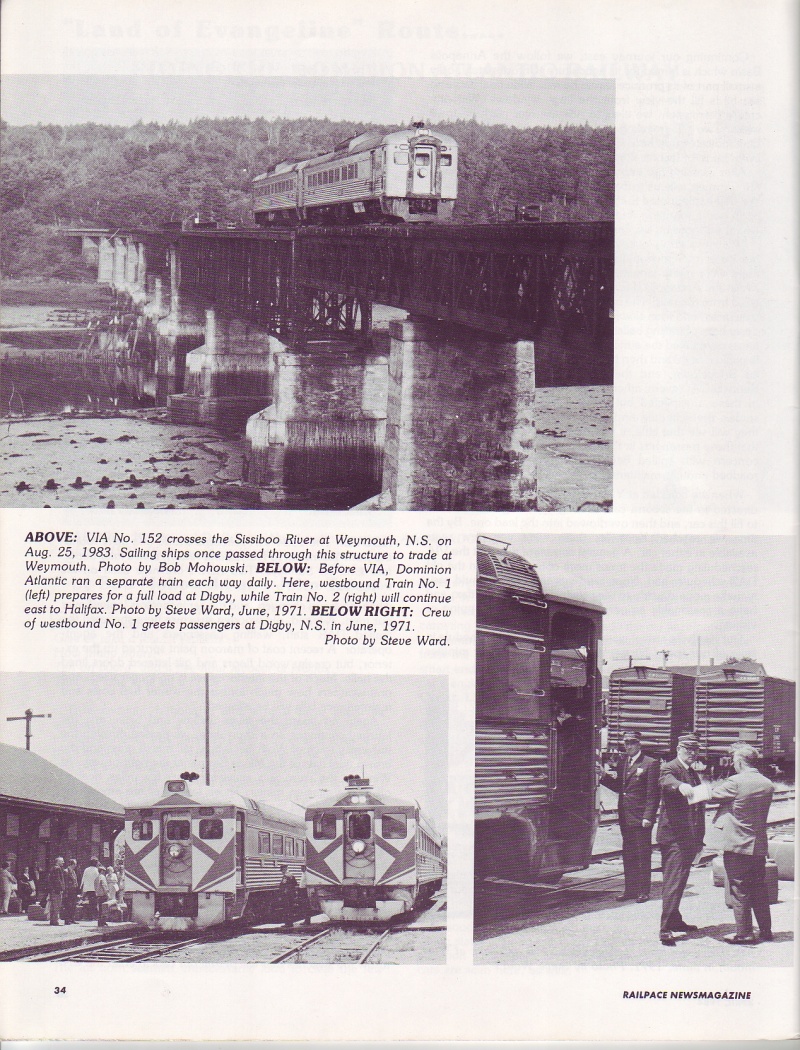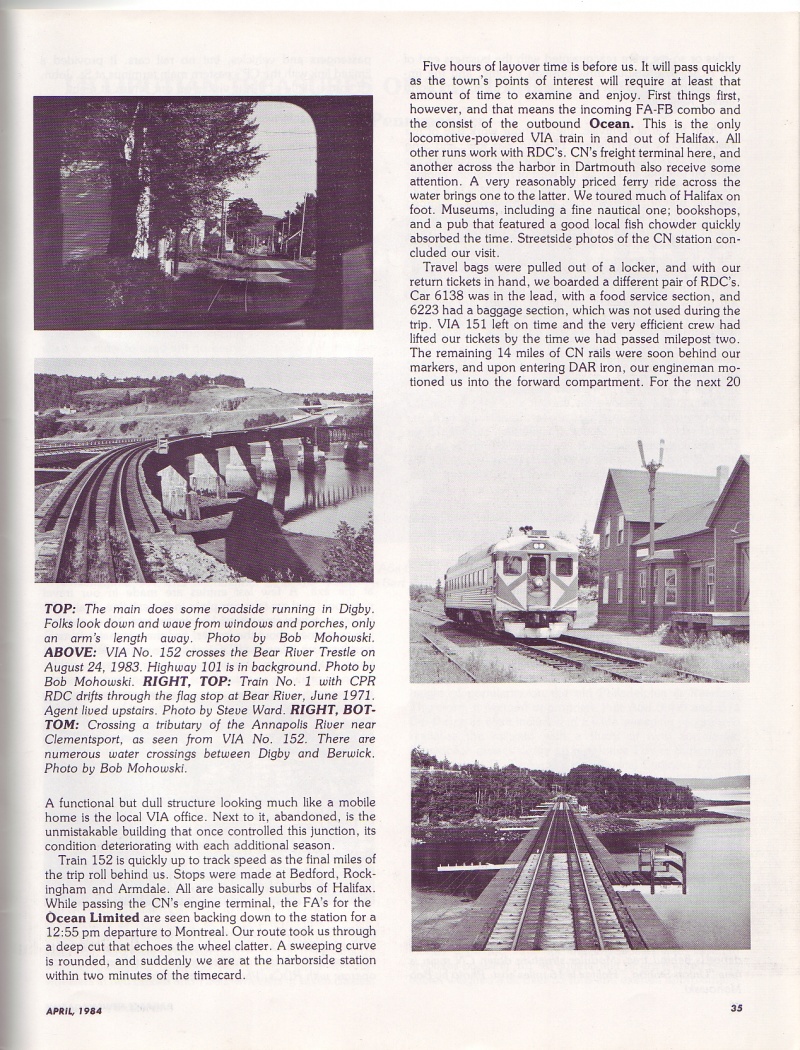Dominion Atlantic Railway Digital Preservation Initiative - Wiki
Use of this site is subject to our Terms & Conditions.
Railpace April 1984 - Riding the Dominion Atlantic Railway
Railpace April 1984 - Riding the Dominion Atlantic Railway
A transcription of the article text (not including captions) follows the pictures for ease of reading and search purposes.





“Land of Evangeline” Route.....
RIDING THE DOMINION ATLANTIC RAILWAY
by Bob Mohowski and John Treen
450 miles roundtrip? John asked.
Give or take a few ... I replied.
How many hours?
Ten on board, and a five-hour layover at Halifax.
Thats a long time on an RDC...
True enough, I thought, and it must have been the stereotyped image of a commuter RDC run that cooled our interest in riding VIA trains 151 and 152 over the route of the Dominion Atlantic Railway. The time table was closed and put away, but the idea was still open to discussion.
A few days later, with our decision made, we arrived in Yarmouth, Nova Scotia. At 7:00 a.m. the following morning, we would board VIA 152 for an on-train sampling of the “Land of Evangeline Route."
There was a ticket line at the flat-roofed brick station, and a pair of RDC’s sat on a nearby service track at 6:30 a.m. If a necessary, the conductor said, the train would be held until all passengers had purchased tickets. With our $27.00 round-trip excursion tickets in hand, we climbed aboard cars 6136 and 6122.
Train 152 was a few minutes-late departing, due to the conductor’s promise. Finally underway, we rocked gently from side to side as the rails led upgrade and out of town. The air horn seemed unnecessarily loud to clear the few cross streets. It fell silent as spruce woods and fog patches closed in. Settled in our seats and travel bags secured, we examined the car’s interior. The neat, clean upholstery, carpeting and decor in general made the car as remote from a commuter RDC as the old North Jersey Coast trains were from the North Coast Limited. The 3-man crew looked smart and professional. If not for the subdued drone of the car’s engine, one might have thought himself aboard the 'Ocean Limited.
An additional 21 passengers were bound for Halifax. In the car ahead, a few “shorts” had closer destinations. A small kitchen provided beverages and light breakfast. Over coffee and pastry we spoke with fellow travelers and crew members. The food service attendant kept the cup filled, and politely answered the typical tourist questions as we sped along. He kindly informed us to watch for the long and high bridge over the Sissiboo River at Weymouth. After this, the next major point of interest was the curves and loops that gently lower us to the elevation of the depot at Digby This is the largest station since leaving Yarmouth, and the conductor tells us that he can usually expect several passengers here that have come over from St. John N.B These people have used the CP's “Princess of Acadia.” At one time, the DAR had a dockside spur where light 4-6-2’s and wooden cars could meet the boat. Like most of the surviving stations along the DAR, Digby’s has received recent attention with repairs and maroon paint. A few CP outfit cars are seen here, as well.
Continuing our journey east, we follow the Annapolis Basin which is famed for its agriculture. Unfortunately, only a small part of its produce leaves by rail. Wide tidal flats and sea birds fill the view from the large windows. With the crew’s permission, we elect to ride the rear platform for a while. Two CP traveling auditors are riding here as well. One indicates that he is an avid Reading enthusiast, and a lively trade of technical information follows.
After crossing the impressive Bear River Trestle, one of the CP men tells us to be prepared for some fast running. We had earlier noted that the track and roadbed seemed to be in good condition, but 85-pound rail and gravel ballast would not account for anything over 60 mph, would they?
“Watch carefully” we were told. The speedometer in our rear compartment would soon tell. After leaving Cornwallis there were many tangent stretches on the level bench between the Annapolis Basin and the hills rising inland, a mile or so from the rails. The needle held steady at 60 mph for a mile or so, and then slowly continued its clockwise travel. A dusty haze of trailing ballast dust became a cloud, and a grittiness permeated the atmosphere of the rear cab. The needle peaked at 80 and then began to descend as we approached Bridgetown, and the more populated areas nearing Kentville. At several other points we rocketed along the line in these unexpected but exhilarating speed runs. If one studies the schedule and compares distances with times, they will see that little, if any, padding exists. It was noted that those passengers in the food service area expressed no concern with spilled beverages; a further indication of roadbed and car maintenance.
When we boarded at Yarmouth, Halifax passengers were directed to the second car. Through passengers continued to fill this car, and then overflowed into the lead one. By the time we reached Kentville, there were very few seats available in either car. A general comment was that the VIA rescheduling made the trains more convenient than the old DAR schedules had. Now, residents and tourists could easily make a one-day trip to the provincial capital, Halifax, and have a reasonable amount of time there for shopping or visiting.
Our Kentville arrival was nine minutes behind schedule in spite of our speed bursts. We detrained for a few minutes while the crews changed, and the car inspectors looked over our train. A grand, old wooden structure here sheltered the limited DAR staff, waiting passengers and the agent-operator. A recent coat of maroon paint spruced up the exterior, but creaky wood floors and gilt-lettered doors lined the halls. Much of the interior space is no longer used, and one wonders how much longer the winter fuel costs and maintenance bills will be allowed.
Again on board the silver, yellow and blue cars, the journey continues. In a short time, we passed through the university town of Wolfville, where tall marsh grass and the brown tidal flats of the Minas Basin met the right-of-way. At Windsor, the Truro Sub, active for only a few miles, headed off to the gypsum mines. Those few miles are among the most profitable for the DAR, as the mineral traffic means income for both the railway and Nova Scotia.
The landscape became more wooded again as the cars climbed toward Ellershouse and Mt. Uniacke. Once again the dust rose while the speedometer needle quivered in the 70’s. Below us, the Avon River flowed toward the basin known for its extreme tides. Soon we crossed the height of land, and began a gentle descent toward our destination. A sweeping curve brought us in view of the CN’s mainline, and the cars slowed for the stop at Windsor Junction. As passengers got on and off, the brakeman walked ahead to throw the switches that will permit our cars to enter the CN.
A functional but dull structure looking much like a mobile home is the local VIA office. Next to it, abandoned, is the unmistakable building that once controlled this junction, its condition deteriorating with each additional season.
Train 152 is quickly up to track speed as the final miles of the trip roll behind us. Stops were made at Bedford, Rockingham and Armdale. All are basically suburbs of Halifax. While passing the CN’s engine terminal, the FA’s for the Ocean Limited are seen backing down to the station for a 12:55 pm departure to Montreal. Our route took us through a deep cut that echoes the wheel clatter. A sweeping curve is rounded, and suddenly we are at the harborside station within two minutes of the timecard.
Five hours of layover time is before us. It will pass quickly as the town’s points of interest will require at least thst amount of time to examine and enjoy. First things first however, and that means the incoming FA-FB combo and the consist of the outbound Ocean. This is the only locomotive-powered VIA train in and out of Halifax. All other runs work with RDC’s, CN’s freight terminal here, and another across the harbor in Dartmouth also receive some attention. A very reasonably priced ferry ride across the water brings one to the latter. We toured much of Halifax on foot. Museums, including a fine nautical one; bookshops, and a pub that featured a good local fish chowder quickly absorbed the time. Streetside photos of the CN station concluded our visit.
Travel bags were pulled out of a locker, and with our return tickets in hand, we boarded a different pair of RDC’s. Car 6138 was in the lead, with a food service section, and 6223 had a baggage section, which was not used during the trip. VIA 151 left on time and the very efficient crew had lifted our tickets by the time we had passed milepost two. The remaining 14 miles of CN rails were soon behind our markers, and upon entering DAR iron, our engineman motioned us into the forward compartment. For the next 20 miles or so we were reacquainted with the business end of an RDC. The unique three-position throttle, and the immediate engine exhaust response recalled a variety of North Jersey RDC rides.
Upon arrival at Kentville, the ten-hour work day of the east end crew was finished. The sun was low, and long shadows crossed the platform as passengers and railroaders went on to other affairs. To the west of the station, engines 8139 and 8132 sat with white flags waving lazily in the light evening breeze. Our two cars accelerated past, clumped over the yard lead switch, and had the single track and the rest of the railway all to themselves. A westbound freight would run tonight, but it would be hours behind 151.
Into the deepening dusk we proceeded; our oscillating warning light throwing a beam to one side and then the other. Our progress was measured by the station signs passing the window: Berwick, Kingston, Middleton and Annapolis Royal. Here was once the capital of French Acadia and perhaps the second oldest European settlement in America. Noteworthy of the Twentieth century is the tidal-powered hydroelectric plant here, which serves as a demonstration project. Leaving town our train passes over a flowage channel that powers the project.
Through the windows on the left side of the train the moon can be seen as it rises above the hills that form the central section of the province. It is not high enough to light our passage over the Bear River Bridge. It is easier to hear our rolling progress over its 1600 feet than to see it. The height of the water beneath varies 30 feet between tides. From the right side of the car two shadowy peninsulas can be seen that mark Digby Gap. The Bay of Fundy tides flow through these into the Annapolis Valley. Digby itself casts a small glow into the night sky, and will be the next stop. Here, the CP once operated “The Pines,” a premier summer hotel. At one time, this contributed to the interesting fact that one could find all four of CP’s travel services here Not only did the CP-owned Dominion Atlantic offer transportation, but CP Ships, CP Communications, and CP Hotels were available to the public. The passenger train is no longer a part of this vast company, but the “Princess of Acadia,” yet owned by CP, links Digby and western Nova Scotia with St. John, New Brunswick. The ship carries passengers and vehicles, but no rail cars. It provided a limited link with the CP’s eastern main terminus at St. John Of course, little of this is visible on our return at night.
After a few passengers detrain, No. 151 begins the looping climb that in two miles will put us 200 feet above town. Some 65 miles of our journey remain, and it has been several hours since the late lunch in Halifax. The steward informs us that his pantry is down to coffee and fresh fruit. A few passengers across from us discuss local affairs while we eat apples and drink the coffee that will suffice for dinner Except for rural crossroad stops, where the lights of parked automobiles indicate those waiting for rail travelers, we roll on through the dark woods. The brief stops are marked by blinking road crossing flashers, brief snatches of departing conversation, and the closing of stair traps and doors as again we continue westward. Except for the moon’s occasional appearances from behind the clouds, the western counties darkness is complete. It’s difficult to resist the dozing off that often marks the approaching end of a rail trip.
With little to observe outside our windows, the mind turns inward. We discuss the road on the basis of what we have seen, and think up additional trip possibilities. Wouldn’t it be possible to take Amtrak from New York to Boston, then a bus from Boston to Portland or Ellsworth, Maine? From both these points, a ship will take you to Yarmouth, N.S. Then back to the rails for a repeat of our eastbound trip over the Dominion Atlantic to Halifax. A connection there with the Ocean Limited will bring the traveler to Montreal. For the final lap back to New York, one has the choice of the Adirondack or the Montrealer. A careful study of all timetables would be in order before embarking on such a long journey. It would be especially important to review the schedules of the two ships sailing from Maine. At any rate it’s a pleasant prospect to consider.
We have noticed that the lights are more frequent, and the few remaining passengers begin to stir. Packages and bags are taken down from the racks and people congregate at the exit. A few last entries are made in our travel notebook, and we take our place in the exit line. Train 151 brakes to a final stop about 17 minutes late. No one seems too concerned about the matter, and there is that final contrast between riding the RDC’s of the Dominion Atlantic and those of the metropolitan area commuter roads...